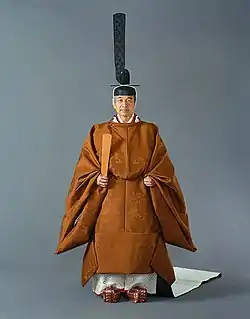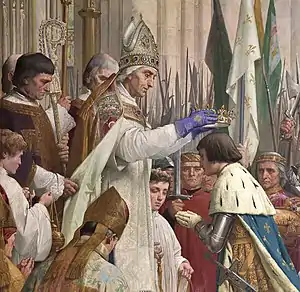Enthronement of the Japanese emperor
The enthronement of the emperor of Japan (即位の礼, Sokui no rei) is an ancient ceremony that marks the accession of a new monarch to the Chrysanthemum Throne, the world's oldest continuous hereditary monarchy. Various ancient imperial regalia are given to the new sovereign during the course of the rite.
| Enthronement of the Japanese emperor 即位の礼 | |
|---|---|
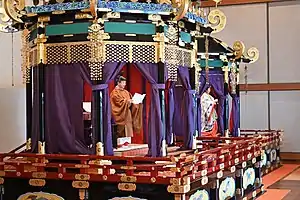 Enthronement of Emperor Naruhito in Tokyo Imperial Palace in 2019 | |
| Country | |
| Inaugurated | After the enthronement of Emperor Kanmu in 781, the original form of the present ritual was completed. |
| Previous event | 2019 Naruhito |
| Participants |
|
| Website | The Imperial Household Agency Cabinet Public Relations Office, Cabinet Secretariat |

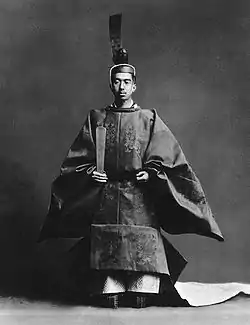
Ceremonies
The Japanese enthronement ceremony consists of three main parts:
Presentation of the Three Sacred Treasures
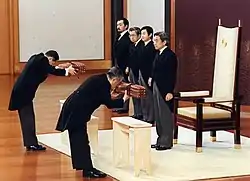
The first is the simplest, Kenji-tō-Shōkei-no-gi (剣璽等承継の儀), it takes place immediately after the death or abdication of the preceding sovereign. The successor is formally presented with boxes containing two of the three items that compose the Imperial Regalia of Japan: (1) a replica sword representing the sword Kusanagi-no-Tsurugi (lit. "Grasscutter Sword") (草薙劍), though the original is allegedly enshrined at Atsuta Shrine in Nagoya; and (2) the Yasakani no magatama (八尺瓊曲玉), a necklace of comma-shaped stone beads. The third and most important of the items of the regalia is the mirror Yata no Kagami (八咫鏡), which is enshrined in the Ise Grand Shrine as the go-shintai (御神体), or the embodiment of the Sun Goddess herself. It is permanently housed in the shrine, and is not presented to the emperor for the enthronement ceremony. Imperial messengers and priests are sent to this shrine, as well as to the tomb-shrines of the four emperors whose reigns immediately preceded his, to inform them of the new emperor's accession.
The three items of the imperial regalia were originally said to have been given by the Sun goddess, Amaterasu, to her grandson when he first descended to earth and became the founder of the imperial dynasty. Unlike other monarchies, Japan has no crown in its regalia. In the 2019 enthronement ceremony, the treasures were presented to the new emperor in the morning of his ascension date. The visits to the Ise Grand Shrine by Imperial messengers and priests, as well as to the tombs of the previous four emperors, continued on as in past enthronements.
Enthronement
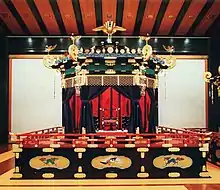
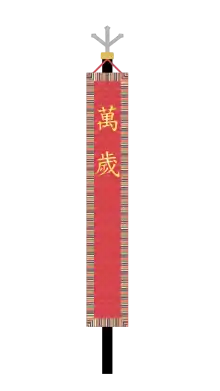
The second part of the ceremony, called Sokuirei-Seiden-no-gi (即位礼正殿の儀), is the enthronement ritual itself; the last such ceremony was held in 2019 for Naruhito. This ancient rite was traditionally held in Kyoto, the former capital of Japan; beginning in 1990, it is done in Tokyo. The 1990 enthronement of Akihito was the first to be covered on television, and have Imperial Guards in traditional uniforms. It was done indoors, with the elevated stand placed inside the Imperial Palace complex. Only part of the ritual is public, and the regalia itself is generally seen only by the emperor and a few Shinto priests. First came a three-hour ceremony in which the new emperor ritually informed his ancestors that the enthronement is about to take place. This was followed by the enthronement itself, which takes place per tradition in an enclosure called the Takamikura, containing a great square pedestal upholding three octagonal pedestals topped by a simple chair. This was surrounded by an octagonal pavilion with curtains, surmounted by a great golden Phoenix.[1] At the same time, the empress, in full dress regalia, moved to a smaller adjacent throne beside her husband's. Traditional drums were, at this point of the ceremony, beaten to start the proceedings.[2]
The new emperor proceeded to the chair, where after being seated, the Kusanagi, Yasakani no Magatama, privy seal and state seal were placed on stands next to him. A simple wooden sceptre was presented to the emperor, who faced his prime minister standing in an adjacent courtyard, representing the Japanese people. The emperor offered an address announcing his accession to the throne, calling upon his subjects to single-mindedly assist him in attaining all of his aspirations. His prime minister replied with an address promising fidelity and devotion, followed by a "three cheers of Banzai" from all of those present. The timing of this last event was precisely synchronized, so that Japanese around the world could join in the "Banzai" shout at precisely the moment that it was being offered in Kyoto or in Tokyo.[1]
This moment of the rite ends with the firing of a 21-gun salute by the Japan Self-Defense Forces. After this, both seals and the two regalia items are carried off the imperial pavilion.
Following this, the emperor and empress, now back to wearing civilian mess dress, are then both driven all over Tokyo via the Imperial automobile convoy to acknowledge the cheers of the people of the capital and tourists assembled on the major streets. On the way the emperor receives his first salute as head of state by police personnel of the Imperial Guard and the 302nd JGSDF Security Company of the Eastern Army, the JSDF's official guard of honour formation, and then by a joint service guard of honour battalion of guardsmen from the headquarters units of the JSDF's three service branches, which present arms and salute on the eyes left. In the past, in his former role as commander-in-chief, he received the salutes of the Imperial Guard formations and assembled formations of both the Imperial Japanese Army and the Imperial Japanese Navy either during the motorcade or while mounted on horseback.
The Daijō-sai
.jpg.webp)
The Daijō-sai (大嘗祭), the first Niiname-sai (新嘗祭) or the Great Thanksgiving Festival, is the third and most important of the inauguration rituals, because it is the one in which the emperor is united to the sun-goddess Amaterasu, in such a way as to share in a unique way in her divinity.
The emperor and empress both perform the Daijosai ceremony a few months after ascending the throne. It is only performed once during their reign. Akihito performed it in November 1990 and Naruhito on 14 November 2019. The purpose is to give thanks and pray for national peace and prosperity. The emperor offers gifts such as rice, kelp, millet and abalone. Then he reads an appeal to the gods and eats the offering and prays. The emperor and empress perform the rites separately. It takes about 3 hours. Over 500 people are present including the Prime Minister, government officials and representatives of society. It originates as a shinto rite from at least the 7th century. It is an event by the Imperial Household so it doesn't violate the separation of church and state. A special complex with over 30 structures are built for the event. Afterward, they are accessible to the public for a few weeks and then dismantled. In 1990, the ritual costed more than 2.7 billion yen ($24.7 million).[3]
Details
First, two special rice paddies are chosen and purified by elaborate Shinto purification rites. The families of the farmers who are to cultivate the rice in these paddies must be in perfect health. Once the rice is grown and harvested, it is stored in a special Shinto shrine as its go-shintai (御神体), the embodiment of a kami or divine force. Each kernel must be whole and unbroken, and is individually polished before it is boiled. Some sake is also brewed from this rice. The two sets of rice seedlings now blessed each come from the western and eastern prefectures of Japan, and the chosen rice from these is assigned from a designated prefecture each in the west and east of the country, respectively.
Two thatched roof two-room huts are built within a corresponding special enclosure, using a native Japanese building style that predates and is thus devoid of all Chinese cultural influence. One room contains a large couch at its center; the second is used by musicians. All furniture and household items also preserve these earliest, and thus most purely Japanese forms: e.g., all pottery objects are fired but unglazed. These two structures represent the house of the preceding emperor and that of the new emperor. In earlier times, when the head of a household died his house was burned; before the founding of Kyoto, whenever an emperor died his entire capital city was burned as a rite of purification. As in the earlier ceremony, the two houses represent housing styles from western and eastern parts of Japan. Since 1990, the temporary enclosure is located at the eastern grounds of the Imperial Palace complex.
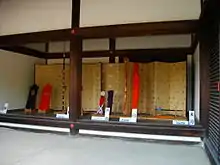
After a ritual bath, the emperor is dressed entirely in the white silk dress of a Shinto priest, but with a special long train. Surrounded by courtiers (some of them carrying torches), the emperor solemnly enters first the enclosure and then each of these huts in turn and performs the same ritual—from 6:30 to 9:30 PM in the first, and in the second from 12:30 to 3:30 AM on the same night. A mat is unrolled before him and then rolled up again as he walks, so that his feet never touch the ground. A special umbrella is held over the sovereign's head, in which the shade hangs from a phoenix carved at the end of the pole and prevents any defilement of his sacred person coming from the air above him. Kneeling on a mat situated to face the Grand Shrine of Ise, as the traditional gagaku court music is played by the court orchestra the emperor makes an offering of the sacred rice, the sake made from this rice, millet, fish and a variety of other foods from both the land and the sea, to Amaterasu. Then he eats some of this sacred rice himself, as an act of divine communion that consummates his singular unity with Amaterasu-ōmikami, thus making him (in Shinto tradition) the intermediary between Amaterasu and the Japanese people.[4][5] This is followed by three banquets and a visit to the shrines of his ancestors.[1]
Gallery

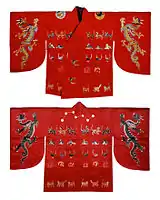
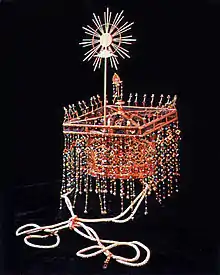


.png.webp)
.png.webp)


 Mockup, layout plan for pavilions in the Daijōkyū for the Daijōsai ceremony in November 2019.
Mockup, layout plan for pavilions in the Daijōkyū for the Daijōsai ceremony in November 2019. Kareta, Special Parade of the Ceremonial Horse-Drawn Carriages 2009
Kareta, Special Parade of the Ceremonial Horse-Drawn Carriages 2009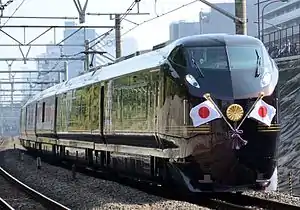 JR East E655 series EMU, the train used by the Japanese imperial family
JR East E655 series EMU, the train used by the Japanese imperial family
References
- "Emperor Enthroned – TIME". Time.com. November 19, 1928. Retrieved October 12, 2008.
- "Japan emperor to announce enthronement in ancient-style ceremony". Mainichi Daily News. October 22, 2019.
- Yukihiro Enomoto. "Japan emperor performs centuries-old succession rite". Nikkei Asian Review. Archived from the original on November 15, 2019. Retrieved September 24, 2020.
- Schoenberger, Karl (November 23, 1990). "Akihito in Final Ritual of Passage". Los Angeles Times. Retrieved May 2, 2010.
- Weisman, Steven R. (November 23, 1990). "Akihito Performs His Solitary Rite". The New York Times. Retrieved May 2, 2010.
Further reading
- Robert S. Ellwood, The Feast of Kingship: Accession Ceremonies in Ancient Japan (Tokyo: Sophia University, 1973).
- D. C. Holtom, Japanese Enthronement Ceremonies: With an Account of the Imperial Regalia (Tokyo: Sophia University, 1972).
- John Breen and Mark Teeuwen, New history of Shinto (Wiley-Blackwell, 2010), pp. 168–198.
